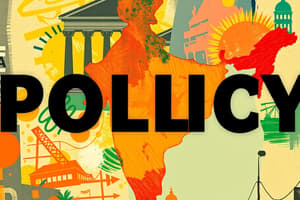Podcast
Questions and Answers
Which of the following is NOT an objective of fiscal policy?
Which of the following is NOT an objective of fiscal policy?
- Stability
- Economic Growth
- Maximizing government revenue (correct)
- Equity in income distribution
What is one of the main roles of fiscal policy during economic recession?
What is one of the main roles of fiscal policy during economic recession?
- To reduce government spending
- To eliminate public goods
- To increase interest rates immediately
- To stimulate aggregate demand (correct)
How does fiscal policy primarily influence economic growth?
How does fiscal policy primarily influence economic growth?
- By adjusting government budgets (correct)
- By controlling the supply of money
- By imposing trade tariffs
- By deregulating financial markets
Which statement correctly reflects the Keynesian view on fiscal policy?
Which statement correctly reflects the Keynesian view on fiscal policy?
Which challenge is commonly associated with implementing fiscal policy?
Which challenge is commonly associated with implementing fiscal policy?
What does the term 'overheating' refer to in the context of fiscal policy?
What does the term 'overheating' refer to in the context of fiscal policy?
In the classical view, what is emphasized regarding government budget policy?
In the classical view, what is emphasized regarding government budget policy?
What is a crucial function of fiscal policy during business cycles?
What is a crucial function of fiscal policy during business cycles?
What is the primary reason fiscal deficit is considered harmful?
What is the primary reason fiscal deficit is considered harmful?
How does high fiscal deficit contribute to inflation?
How does high fiscal deficit contribute to inflation?
Which of the following best captures the relationship between fiscal deficit and public debt?
Which of the following best captures the relationship between fiscal deficit and public debt?
Which indicator is NOT considered a macroeconomic indicator of fiscal deficit?
Which indicator is NOT considered a macroeconomic indicator of fiscal deficit?
What is the outcome of a monetized fiscal deficit on the money supply?
What is the outcome of a monetized fiscal deficit on the money supply?
Which of the following is an objective of fiscal policy?
Which of the following is an objective of fiscal policy?
Which of the following challenges is associated with fiscal policy?
Which of the following challenges is associated with fiscal policy?
How does fiscal policy typically respond to business cycles?
How does fiscal policy typically respond to business cycles?
What is one of the primary objectives of fiscal policy?
What is one of the primary objectives of fiscal policy?
Which component is NOT included in the GDP equation?
Which component is NOT included in the GDP equation?
How does increasing government expenditure during a recession directly affect the economy?
How does increasing government expenditure during a recession directly affect the economy?
Which of the following describes a risk of using fiscal policy to address an overheated economy?
Which of the following describes a risk of using fiscal policy to address an overheated economy?
Which of the following is a target variable associated with government borrowing?
Which of the following is a target variable associated with government borrowing?
What should be done according to fiscal policy when an economy is at risk of recession?
What should be done according to fiscal policy when an economy is at risk of recession?
Which of the following functions is NOT a direct function of fiscal policy?
Which of the following functions is NOT a direct function of fiscal policy?
According to fiscal policy principles, which action would be most appropriate to combat inflation?
According to fiscal policy principles, which action would be most appropriate to combat inflation?
Flashcards are hidden until you start studying
Study Notes
Understanding Fiscal Policy
- Fiscal Policy (FP) involves government budget implementation affecting income (receipts) and expenditure, aimed at influencing macroeconomic variables.
- Fiscal Policy equation: GDP = C + I + G + NX; GNI includes net receipts (NR): GNI = C + I + G + NX + NR.
Function of Fiscal Policy
- Policy Variables include taxation, government expenditure, subsidies, and government borrowing/deficits.
- Target Variables impacted: real GDP, employment, consumption, savings, investment, equitable income distribution, exports, housing, and specific goals.
Fiscal Policy and Business Cycles
- In a recession, measures include increasing government expenditure, reducing taxes, and running a budget deficit.
- Risks during recession management: potential inflation, asset price bubbles, and currency depreciation.
- For an overheated economy, policies involve reducing government expenditure, increasing taxes, and running a surplus budget, with risks of recession.
Historical Perspectives on Government Budget
- Classical view emphasizes laissez-faire, balanced budgets, and public goods, recognizing market failures during the Great Depression (1929-33).
- Keynesian view argues for active government intervention to balance aggregate demand (AD) post-Great Depression, highlighting failures of consumption (C) and investment (I) in economic recovery.
Objectives of Fiscal Policy
- Aims include promoting economic growth, stability throughout recession and overheating phases, and equitable income distribution.
Trends in Fiscal Deficits
- Fiscal Deficit = Government Borrowings.
- Revenue Deficit = Revenue Expenditure – Revenue Receipts.
- Effective Revenue Deficit = Revenue Deficit - grants aiding capital asset creation.
- Primary Deficit = Fiscal Deficit – Interest Payments.
Risks of High Fiscal Deficit
- Impact on Interest Rates: High borrowing raises demand for funds, leading to increased interest rates, which may crowd out private investment.
- Impact on Inflation: High deficits can build inflationary pressure through excess demand and increased money supply.
- Impact on Public Debt: Accumulation of fiscal deficit results in rising public debt, critical indicators as % of GDP.
Key Indicators
- Public Debt as a % of GDP and Fiscal Deficit as a % of GDP are vital macroeconomic indicators.
- Tax GDP ratio estimated at 82% in 2023.
Studying That Suits You
Use AI to generate personalized quizzes and flashcards to suit your learning preferences.




